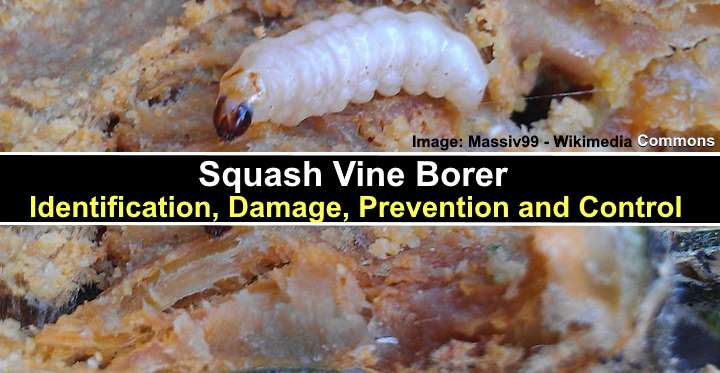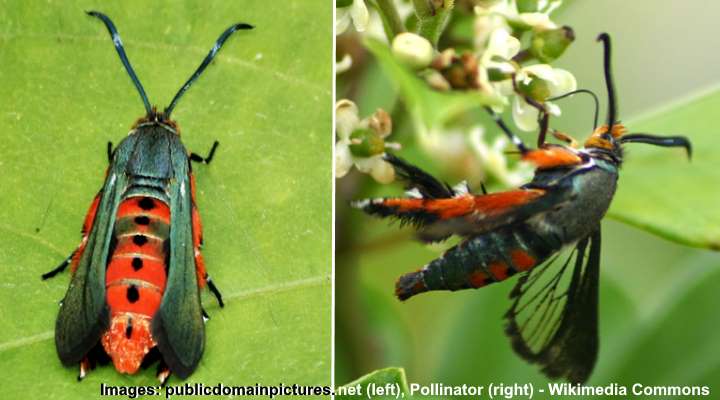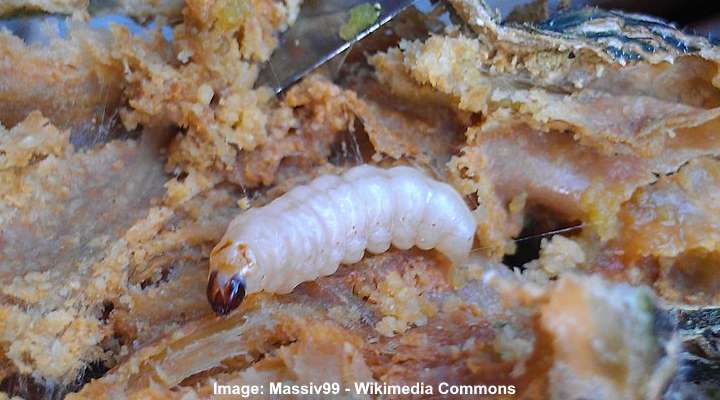Squash Vine Borer: Identification, Damage, Prevention and Control (Pictures)

The squash vine borer is a white grub or larva which tunnels inside squash, pumpkin, and gourd plants, destroying the plant vines from the inside. The first sign of squash vine borer damage is wilting leaves on a Cucurbita plant. Unfortunately, when damage to squash plants is visible, it’s probably too late to save the infected plant. Preventing adult squash borers from laying eggs is the best way to prevent and control squash plant damage.
This article is a complete guide to controlling squash vine borers in your garden. Because getting rid of these pesky grubs is challenging, you will learn about a multi-method approach for eradicating the squash vine borer eggs. Additionally, finding out about the squash vine borer’s life cycle can help control this plant-destroying pest.
Squash Vine Borer (Melittia cucurbitae) Facts
White grubs living in squash plants are the larval stage of squash vine borer moths. The female moths lay eggs at the bases of plants in the Cucurbita family. Squash plants are primarily affected, and you may notice squash vine borer activity around pumpkin, zucchini, and acorn squash plants.
Squash vine borer moths are harmless flying insects. The moths are active during the day and rest on plant leaves in the evenings. The moths have an orangey-red abdomen with black dots. In addition, squash vine borer moths have a pair of wings that are metallic greenish-black. In flight, they tend to hover and then move in a zig-zag pattern.

Squash vine borer moth
The name squash vine borer applies to the grubs that feed on squash plants and to the adult moths after they emerge from their pupae.
Squash Vine Borer Control
Prevention is the best way to control squash vine borer larvae. Effective natural control methods for squash vine borers involve destroying all squash plant debris at the end of the season and using crop rotation techniques. Additionally, using row covers, removing eggs, and planting borer-resistant squash plants can help prevent grub damage.
What Does Squash Vine Borer Look Like?

Squash vine borer larva
Squash vine borer grubs look like fat creamy-white colored worms with wrinkled bodies and brown or black heads. The whitish caterpillars are difficult to see because they spend their life burrowing through squash vines. The fat white larvae grow 1” (2.5 cm) long. Then, they burr into the ground and overwinter as brown pupae.
Squash Vine Borer Life Cycle
A squash vine borer’s life cycle starts as an egg at the base of a squash plant. The egg hatches after seven to ten days, and the tiny larva bores into the squash plant stem. The white grub feeds on stems for four to six weeks, depriving the plant of water and nutrients.
After the squash borer larva has become a plump wrinkled grub, it burrows into the ground to pupate. The brown pupa remains in the ground until the following summer when it emerges as an adult squash vine borer—a brightly colored fuzzy moth.
Female squash vine borer moths start laying eggs after emerging from the pupae. A female can lay between 150 and 200 eggs in her lifetime. From hatching until larvae pupation takes four to six weeks. After emerging from pupae, female moths live for up to five days and males, three days.
Squash vine borer eggs
You will find the squash vine borer eggs at the bases of squash plants. The squash vine borer eggs look like reddish-brown flattened oval specks. The tiny moth eggs are difficult to spot because they are only 0.04” (1 mm long). Sometimes, the adult female moths lay eggs in the ground, making them impossible to find.
Squash vine borer larvae
Once the eggs hatch, larvae about 0.08” (2 mm) long emerge. The tiny caterpillars burrow into the squash plant vine where they start doing severe damage. The creamy-white grubs gorge on the plant tissue until they grow 1” (2.5 cm) long. The hungry larvae feed continuously for four to six weeks.
If you suspect squash plant damage, you can sometimes cut open the stem to remove the black-headed white grubs inside.
Squash vine borer pupae
Squash vine borer larvae overwinter in the soil. Typically, they spin dark-colored silk cocoons about 0.8” (2 cm) long and buried 1” to 2” (2.5 – 5 cm) in the ground.
Squash vine borer pupae buried in the ground is why controlling these pests involves crop rotation and destroying old squash plant material. However, yearly rotating squash plants, tilling the soil in the fall, and burning dead squash vines prevent vine borers from continuing their damage.
Squash vine borer adult moth
The adult squash vine borer is a slightly furry, orange moth with iridescent greenish-black wings. The green and orange moths grow up to 1” (2.5 cm) long with a wingspan of 1 to 1.5” (2.5 – 4 cm). Squash vine borer moths are identified by their orange abdomens with a line of black dots down the center.
Where Do Squash Vine Borers Come From?
Squash vine borers appear after the female moths emerge from the ground and lay eggs at the base of squash plants. For up to six weeks, the larvae will go undetected while they munch through the inside of squash plant vines. The engorged larvae then leave the destroyed plant and bury themselves in the ground.
The squash vine borer is native to North America, where it causes considerable damage to squash, pumpkin, and zucchini plants. Populations of the grubs and moths occur from Florida to southeastern Canada and west as far as Texas and North Dakota.
Where Do Squash Vine Borers Live?
During their larval stage, squash vine borers live exclusively in plants belonging to the Cucurbita family. The whitish grubs mostly live in the squash vines; however, they may also reach the fruit. During the pupal stage, squash vine borers live in dark-colored silk cocoons about 2” (5 cm) deep in the ground.
What Do Squash Vine Borers Eat?
As the name implies, squash vine borers feed on squash plants by boring into the vines. During the larval stage, the grubs spend their life eating through the soft tissue inside squash plant stems. This damage causes the squash leaves to wilt, turn yellow, and the plant eventually dies. The grubs eat squash, pumpkin, zucchini, and gourd plants.
How to Identify Squash Vine Borers (Melittia cucurbitae)
Squash vine borer larvae are almost impossible to identify because they spend their life inside squash plant vines. Typically, damage to squash plants is the only way to recognize issues with squash vine borer grubs. By this time, the squash plant is almost impossible to save.
Adult squash vine borers are harmless moths with black heads, an orange abdomen with black dots, and furry orange and black legs. You will often notice moths darting around gardens during the day and resting on leaf bases at dusk or in the early morning.
It’s vital to trap squash vine borers if you see them on squash plants because they are probably laying eggs.
How to Identify Squash Vine Borer Damage
A sign of damage from squash vine borers looks like wilting leaves. The damage occurs as the plant-destroying larvae eat the inside of squash vines, preventing nutrients and moisture from nourishing the plant. Eventually, the entire plant will wilt.
Another sign of squash vine borer damage is fecal matter that looks like sawdust. This yellowish substance is visible at holes on the stem where the plant wilts.
How to Prevent Squash Vine Borers
Prevention is paramount when it comes to controlling squash vine borers. A multi-method approach for pest control should help prevent moths from laying eggs and avoid planting squash plants where the grubs previously caused problems. But, first, let’s look at some practical ways of controlling squash vine borers without chemicals.
Prevent Squash Vine Borer Using Crop Covers
Floating crop covers are an excellent way to prevent squash vine borer damage. The time to place the covers is when the crops start to vine, or you first notice squash vine borer moths. It’s vital to keep covers in place for two weeks to prevent egg-laying.
When using crop covers to prevent squash vine borers, here are a few things to keep in mind:
- Crop covers can prevent pollination. Therefore, remove the covers when crops are blooming to allow pollinators. Alternatively, you can self-pollinate squash plants to ensure a healthy crop.
- Don’t use crop covers if squash plants were planted in the same location as the previous year. Larvae live in the ground and can easily infect plants when they emerge.
- Secure row covers to prevent adult squash vine borer moths from getting inside to lay eggs.
Prevent Squash Vine Borers By Planting Squash Early in the Season
An excellent way to prevent squash vine borer damage is to plant squash early in the season. This way, the vines will be strong enough to withstand larvae damage which often occurs in mid-summer. Depending on the climate, the squash crop may be ready before the grubs are active.
Top tip for preventing squash damage: If you have late frosts, protect early-planted squash from frost by using a layer of hay, old blankets, or broken-down cardboard boxes.
Crop Rotation Helps Prevent Squash Vine Borer Larvae
A vital control method for squash vine borer grubs is to practice crop rotation. Squash borer larvae live in the ground, and they emerge just as squash vines are getting established. Therefore, planting cucurbit plants in a different location every other year makes it difficult for them to infest their host plants.
However, you still need to check all squash plants regularly for signs of eggs and early larval activity.
Protect Plant Stems from Squash Vine Borer Damage
Using physical barriers to prevent squash borer larvae from getting into vines can protect your crop. For example, you can try covering cucurbit stems with aluminum foil or nylon stockings as a non-toxic way to control squash borers. Cover the stems 3” (7.5 cm) high from soil level. This way, you effectively prevent adult moths from laying eggs.
Prevent Squash Vine Borers By Planting Resistant Squash Varieties
Plant varieties of squash that are more resistant to squash vine borers. For example, squash in the Cucurbita moschata family, such as butternut squash, are more resistant to squash vine borers and other pests. You could also grow squash plants from Cucurbita mixta—these plants are also resistant to squash bugs and borers.
Grow Plants That Deter Squash Bugs
As part of your battle with eradicating squash bugs, you could try companion planting. Some gardeners suggest planting radishes near squash plants as they are said to repel moths and other common garden pests.
Squash Vine Borer Traps to Prevent Egg Laying
To reduce populations of adult squash vine borers, try using traps to catch the moths before they lay eggs.
You could place yellow-colored containers containing soapy water beside your squash plants. The idea is that the squash vine borer moths are attracted to yellow color, and they will fly to the container and get trapped in the soapy water. Lay the squash borer traps from late June through July.
Another way to “trap” squash vine borer larvae is by planting a small crop of Hubbard squash early in the season. Hubbard squash is highly susceptible to vine borer infestations. Moths will lay most of their eggs on the early planted “trap crop,” thus alleviating larvae pressure on other squash crops.
Destroy Squash Vines After Harvest to Reduce Squash Vine Borer Populations
After you harvest the crop at the end of each season, collect all parts of the vine and discard them in the compost. Additionally, tiling is vital to destroy any larvae that are overwintering in the soil. This way, you can help prevent squash vine borer infestations the following year.
How to Control Squash Vine Borers
It is tricky to get rid of squash vine borers from the plant when they have started causing damage. However, there are a few effective methods to eliminate the grubs before they destroy your plants.
Use Spinosad to Kill Squash Vine Borer Eggs
Spinosad can help kill squash vine borer eggs and immature larvae. You can spray the natural insecticide at the base of squash vines to eradicate borer eggs and kill larvae before they do damage.
According to research, using Spinosad for squash vine borer control “can be as effective as some pyrethroids to control squash vine borer under conventional management.” In addition, Spinosad can have practical applications in organic gardening.
Control Squash Vine Borers By Using Bacillus thuringiensis (Bt) Sprays
Bacillus thuringiensis is a naturally occurring soil bacteria that acts as a natural insecticide. Research has shown that spraying plants or injecting squash vines with a Bt solution can effectively kill squash vine borers. Additionally, Bt for squash borer control is safe for growing squash organically.
Studies have shown that Bacillus thuringiensis (Bt) is “as effective at controlling squash vine borer as the previous industry standard of endosulfan, often preventing infestations entirely.”
Inspect Squash Plants Regularly to Remove Eggs
Control squash vine borers by inspecting the stems and removing eggs by hand. The tiny brown oval eggs take seven to 14 days to hatch. So, inspect the base of stems daily to check for and to remove the eggs. At the same time, you can look for evidence of a borer inside the plant by looking for a hole and sawdust-like material.
Cut Squash Vine Grubs Out of Plants
It is possible to cut immature larvae out of squash plants before they do irreparable damage. First, look for the tell-tale holes at the base of squash stems. Then wait until dark and shine a flashlight on the stem. The dark areas of the stem will indicate where the nasty grubs are living.
If you discover any larvae, make a careful slit on the stem lengthwise and remove the grub. Then drop it in a cup of soapy water to kill it. Alternatively, you can put a toothpick through the stem and grub to kill it instantly. Then cover the affected part of the stem with mulch.
Squash Vine Borer Control and Prevention — FAQs
Does neem oil prevent squash vine borers?
A neem oil spray can help prevent vine borers from infesting squash plants. First, make a natural insecticide by combining 2 tsp. neem oil, 1 tsp. liquid Castile soap, and 1 quart (1 l) of water in a spray bottle. When the adult moths are active, spray the base of the stems with the neem oil solution to kill eggs.
It’s good to remember that you should only rely on a neem oil spray to control vine borer larvae. Neem oil won’t kill any larvae already living in the plant.
Will diatomaceous earth kill squash vine borers?
Diatomaceous earth (DE) is not effective for killing squash vine borer larvae. The white powder may deter adult vine borer moths from laying eggs. However, DE is not as effective as the standard prevention methods for squash vine borer prevention.
Related articles:
